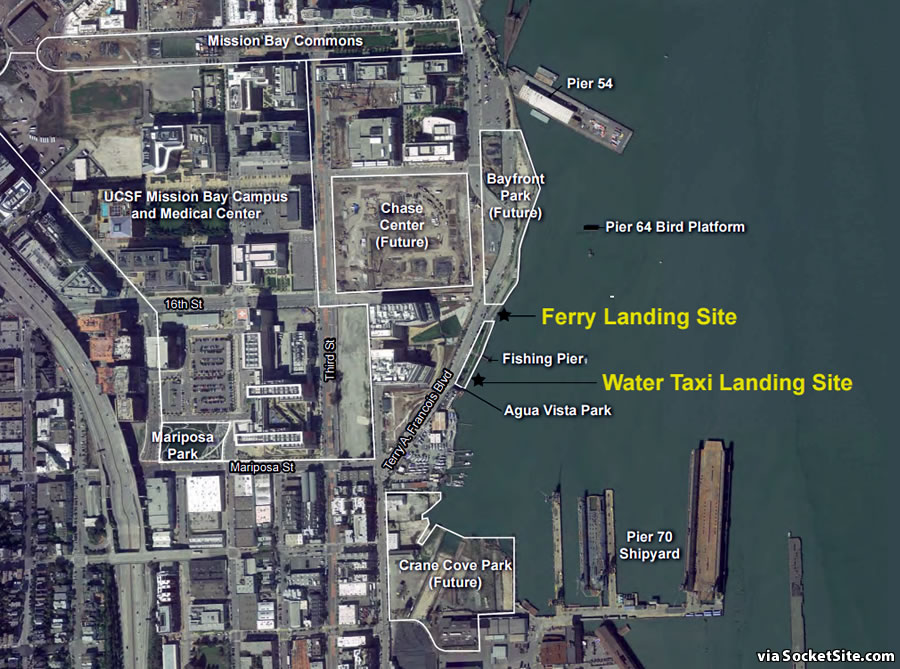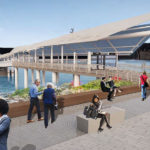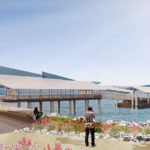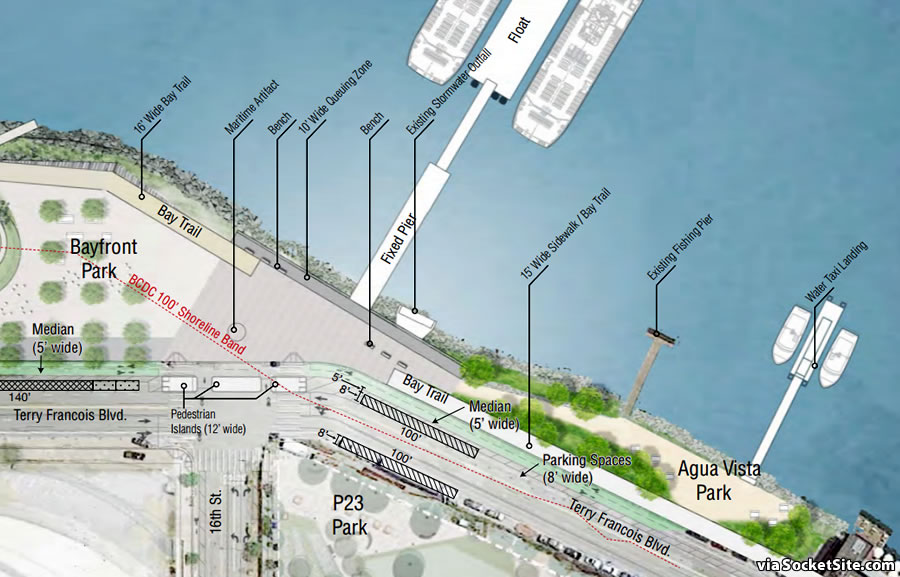As we first reported earlier this year:
If the Port’s plans are approved as proposed, and dredging commences in mid-2019 as currently envisioned, San Francisco’s future Mission Bay Ferry Landing near the intersection of Terry A. Francois Boulevard and 16th Street, cater-corner to Chase Center and adjacent to the future Bayfront Park, could be now operational as early as the first quarter of 2021, as newly rendered below.
A proposed Water Taxi Landing, which is to be located approximately 400 feet south of the proposed Ferry Landing, adjacent to Agua Vista Park, could be operational six months earlier (August 2020).
And in addition to peak hour services to and from Alameda-Oakland, Vallejo and potentially Larkspur, linked via San Francisco’s Ferry Building terminal, special event services would be provided for all scheduled Golden State Warriors’ games and around 20 other big evening or weekend events at the Chase Center.
And according to an environmental review by Planning, which was inked on Monday, “there is no substantial evidence that the project could have a significant effect on the environment,” which should clear the way for an approval of the project and “water breaking” in 2019 to proceed.





good news overall. with all these graphics maybe the design firm can get some credit?
Right? Sometimes I feel like the editorial team goes out of their way to avoid crediting designers. “At least we put it in the footnote tags! Except when we don’t.” The previously linked article is missing the info as well, until you scroll down to the comment section and realize someone else had the same exact question, and SS finally provided an answer. Maybe because this is a site dedicated to “real estate” and not “architecture” — because there’s clearly no relationship between the two… ?
Serious question to the editorial team — why are designers rarely credited in articles here, and often relegated to footnotes?
Oh, and from the previous article, the designers are “Robin Chiang & Company in conjunction with COWI/OLMM and Surfacedesign Inc. (and subject to change).” ?
Will there be a water ferry from Berkeley or Emeryville?
Why does it look so rinky dink?
What does that even mean? It’s a nice ferry landing built with modern materials, and will have the capacity to handle game night crowds.
and three years?
I agree it looks rinky dink, but in a way that lower profile is nice. Very ‘boating marina’ versus ‘SALESORCE AQUATIC TRANSIT HUB’
The size and shape of it is completely based on its function. People wait outside until the boat docks, people walk off, people walk on. The original commenter seems like they might not have ever used one.
I think they (or s/he really) is looking for something grander, like the Ferry Bldg, or the Staten Island Terminal; which makes sense for a facility used by millions – I believe the former peaked @ ~50M transits/yr – but not for one that aspires only for thousands.
We need to be doing a lot more of this. Was in Stockholm last week and their ferry network is super efficient (and costs the same as a bus ride).
There should be a system wide water taxi EIR. Seems like a no brainer…
This is a great idea!
Speaking of ferries, work on the new Richmond terminal continues. Regional Measure 3 funds will support the purchase of new boats for WETA for Vallejo and Richmond.
I’m more interested in the Pier 64 bird platform!
It was a lot more fun before the Port ripped out the portions easily accessed at low tide, complete with garden lounge chair. I guess liability fears won out?
You might be thinking of the Detailed Plans for the Future of Pier 70’s Shoreline versus the landing in Mission Bay.
Would be nice to include a Public Dock like in Jack London Square, Pier 1 1/2, etc… I feel like SF really underutilizes the shoreline compared to other cities.
Agreed! I think this is true for the entire Bay Area.
I would be more enthusiastic if ferries weren’t so heavily subsidized. We’ll see how much these are subsidized. We’d be better off spending that money on Bart.
(For your first statement) Thank you !!
That’s not a binary choice.
Isn’t it? We have to decide how to worms our money. Isn’t it better to spend money on transit improvements that will serve the most people?
“Isn’t it?”
No, it’s not.
Why should we not spend our money on the system that helps the most people?
We should spend money on both. What do you not understand about “not binary”? It’s an incredibly simple concept.
To clarify what Anonymous means by “binary” is that it is not an either/or decision. It can be both. There’s value in having diversity in transportation, something this country forgot after WWII and is just now coming back to.
We should not spend money on both because money spent on one bring significantly more benefits to a greater group of people than money spent on the other.
If we have $1M and spent it all on Bart, the temptation is to say “Ok, let’s raise another $1M, and spend that on ferries.” But we should give that next $1M to Bart also, or maybe to MUNI. (According to the chart below, Bart loses about $1/person per ride. Muni loses about $3/person per ride. The numbers aren’t clear on the ferries but it the floor seems to be $10/person per ride and it goes up from there.)
Spend money where it does the most good. It’s an incredibly simple concept.
It’s not binary. It’s not BART or Ferries. It’s BART or Ferries or everything else. Like say bombing 7 countries over the past 8 years. We spend quite a bit of money on munitions and VA benefits for soliders returning with psychosis or missing limbs. If we weren’t doing that – there would be plenty of money for BART and ferries.
Agreed our urban policy is about making wise choices to benefit the most number of people with the resources we have. But given we gave 6,000+ crazy homeless people living on the streets of SF, many of whom are VETS, and the oldest subway car fleet (BART) in the country, I’m kinda doubting spending less money on Ferries is actually going to improve things. Kind of misses the elephant in the room.
We waste a ton of money. All of which would better be spent on Bart and Muni, which offer the most benefit to the most people.
Beyond a ridership which has doubled over the past six years, there’s a rather good reason the subsidized ferry service is kept in operation, and in a constant state of readiness, by WETA (the Water Emergency Transportation Authority).
If we are preparing for the possibility of the bay bridge and Bart being stopped after the big one, is this dock part of the plan? I would guess those ferries would go to the Ferry Building.
“If we are preparing for the possibility of the bay bridge and Bart being stopped after the big one, is this dock part of the plan? I would guess those ferries would go to the Ferry Building.”
A FEMA report I read quite a while ago predicts that the main ferry building docks will be destroyed in the Big One, presumably via liquefaction. Same for Pier 41, That report is now quite old but I don’t know if there’s been any seismic updates on those big docks since then.
These new ferry terminals are hopefully being built to withstand a large quake.
The Need And Numbers For San Francisco’s Ferry Terminal Expansion (and upgrading), which is now Underway.
I think SFRealist gets to a point that the Bay Area Ferry system has a huge disadvantage in it has to cover a lot of water from point to point. So the trade off gets to be smaller fast ferries costing more to run but carries less people vs. a larger but much slower ferry that would add significant commute time. Example of extremes would be Vallejo fast ferry service to downtown vs. Staten Is. ferries to lower Manhattan.
Thus the Ferry system even with expansion will continue to marginally mitigate traffic at a significant cost vs. buying BART cars or getting BART into downtown SJ or adding commuter rail service over the old Dumbarton rail bridge.
BART takes 35 minutes to go from Richmond to Embarcadero. The SF Bay Ferry takes 60 minutes from Vallejo to the Ferry building. When you adjust for the extra distance to Vallejo, the ferry isn’t significantly slower.
Tideline between Berkeley and Pier 1.5 takes 20 minutes, again, about the same speed adjusted for distance.
It’s not about speed. It’s that they’re so much more expensive on a per passenger basis than Bart.
Only true if you don’t amortize the costs of constructing a BART extension to the stadium. Truth is all transportation mediums including roads and sidewalks are heavily subsidized.
Bart is never going to the stadium. But the money to build the Bart tunnel has already been spent. I would much rather spend this money on new cars, or a state of the art control system, or one of the many improvements which would help the hundreds of thousands of people who take Bart every day instead of the few hundred who will sometimes take the ferry.
Is Bart not subsidized? What’s the difference on a $ per commute basis? I am sure there is one, I just wonder what the actual difference is. The ferries don’t require a separate police force, for example, at least in my experience.
The Chronicle had an article a couple of years ago that the ferry subsidy is about $100/person per ride.
The WETA system has approximately 2.7 million riders annually (up 8% from 2016), and the Golden Gate Ferry has 2.5 million approximately.
If your $100 subsidy number is correct, that means we subsidize ferry ridership by $520mm per year. That sounds high to me. The new large fast boat ‘Hydrus’ that was put into service in Vallejo recently cost $15mm.
I’m all for transit that is effective.
If the Vallejo one is subsidized at $15M/year and carries 1.2M people, that’s about a subsidy of $10/person per ride. According to this, Bart loses about $1 per trip.
Your math works I suppose if every boat lasts for one year and everyone rides for free.
My numbers are from the link you provided. What numbers are you using?
Right numerator, wrong denominator (the referenced budget, and non-fare portion, was system wide).
So what are the proper numbers?
From the article I linked ballpark numbers for WETA are 50% in “non-ticket” sources.
A similar number from BART per the 2018 operating budget is $338mm out of $917mm or 37%.
On this metric, it is absolutely correct that fares make up less of the overall budget for WETA than BART – but the ferry ‘subsidy’ is about 1.35 times greater than BART.
I agree that BART in general is more cost efficient than ferry boats, though of course every person on a ferry is another body not on the Bay Bridge or on the BART train. Expanding Bart to Vallejo isn’t realistic, but the ferry is a good answer for the 1.2 million annual trip-takers who choose to make it their option.
Finally, once the bridge tolls ratchet up another $3 you will see further demand for commuter ferries and BART, and adding more boats is a lot easier than adding new tunnels and train stations.
What is the difference in subsidies on a per ticket basis? That’s the proper measure.
If I buy a $14 ticket to travel 30 miles from Vallejo to SF and you buy a $4 ticket to go 2 miles from Oakland to SF should the dollars of subsidy be the same for both riders? I don’t think so, which is why the operating budget approach makes more sense IMHO.
Considering that a ferry is significantly more polluting than Bart, I’m not sure why ferry subsidies should count for less.
I hadn’t even considered pollution in the discussion, but great. Where’s your data on Bart being less polluting than a ferry boat? What metric? What’s the amount of pollution per Bart rider or per ferry rider?
Extending BART to Vallejo is just as unrealistic as extending BART to San Jose. When and if Solano County voters decide to stump up the money, it’ll become realistic.
I think you missed my point. The ferries are doing a decent job, and extending BART to Solano is indeed unrealistic.
We’re working to solve a REGIONAL problem, which is why the recent bridge toll increase was a REGIONAL vote. Saying Solano County should pay for a BART extension is like saying Santa Clara County should pay for two more lanes on 101 between the city and San Jose.
Incidentally, the RM 3 funds allocate $875mm to new BART projects, far less than the $300mm more than the ferry system is slated to get.
Puleeze!! It was a “regional vote” because if it had been restricted to the people that are actually going to be paying for it, it would have lost…badly. Let’s not confuse milking a cash cow with good government.
There’s an old Chronicle article that ferries are ten times more polluting than cars. (Not surprising, as they use internal combustion engines)
Bart is powered by electricity and is more efficient. One Bart rider gets about 225 miles per gallon in the worst of circumstances. By 2021, they expect to get 90% of their electricity from renewable sources. And Bart does so with a lower subsidy.
b_e_o, I took your point and I fully accept that it’s a regional problem, which is why I used the BART to San Jose example.
BART didn’t run into Santa Clara county upon system completion because when BART was originally proposed, voters didn’t want to pay the increased sales taxes to pay for it, while those in Alameda and Contra Costa counties planned for the future and did so.
BART (or VTA depending on your point of view) is planning an extension to San Jose now because voters approved two different sales tax measures, one in 2000 and another one in 2016, to fund it, and so BART to San Jose is now “realistic”. The same would be true of a BART extension to Vallejo, or indeed anywhere else in Solano County.
That “$100” figure was for a single, new (at the time, circa 2012) line between Oakland and South San Francisco, a route which was never expected to operate without the benefit of a subsidy.
Philosophically, I agree. Though remember that we pay for roads as well.
Practically though, government financing is so opaque and complicated that I find it impossible to get unbiased numbers comparing how much we subsidize and how many people are served by various transportation modes.
Aren’t freeways subsidized? Why are Americans so obsessed with monetizing everything?
Freeways are definitely subsidized. Which is why we should invest in mass transit that benefits as many people as possible.
No bus stops at 16th/3rd. Ya gotta love foresight.
The 55 stops one block away at 16th/4th.
There’s also the T – which not exactly at 16th, is basically right there. Plus, there’s the Mission Bay loop shuttles, which aren’t too bad. The 91 and 22 are also within a block.
In practice, it’s not that bad (for muni..). I imagine as Mission Bay grows it will make sense to tweak stops and add routes.
There’s value in buses, ferries and trains that diversity provides in times of crisis when BART has trouble or Bay Bridge is closed. If we’re really going to chase the next cheapest passenger, then we should give all the money to SF Muni rather than VTA. However, the voters decided that diversity is good, and all transit forms should be funded.
Awesome! Another chance for me to continue the drumbeat of “why can’t the ferry landing and water taxi landing be combined to facilitate easy transfers between (hopefully… fingers crossed…) coordinated services?”
@Notcom if your point is that only people who pay taxes should be able to vote on them, then maybe you should find a spot in the current White House administration. That’s not how America has traditionally rolled, enfranchisement wise.
@SFRealist – I’m confused about Bart being powered by electricity and getting 225 miles per gallon in the worst of circumstances. Are those metric gallons of electricity? I’m being flip but you haven’t really supported your assertion with data. WETA promotes the Hydrus class as the “the Hydrus is the cleanest 27 knot, 400 passenger ferry in the world – is setting the standard for low emissions and minimized environmental impact.”
Again, I expect BART is more efficient fuel-wise than boats, but like your original assertion that a ferries were subsidized $100 per ride vs. $1 for Bart, (when the truth is WETA is subsidized 35% more than BART) I would want to dig into some numbers before assuming some huge disparity.
Wasn’t the BART system designed 70 years ago? Has the electrical system design been constantly upgraded? Something tells me the system isn’t super efficient at present.
Mine was a statement of political realities; and “traditionally” in America – even California – bridge tolls went to pay the cost(s) of building/operating the bridge. The concept that CoCo County commuters – Cocococo’s ?? – should pay for road/transportation projects heavily weighted toward the Southbay b/c they’re “regional” is a more recent construction; but I look forward to SC county sending me a rebate check from property taxes so I can replace my Camelia….hey it’s all one big regional landscape, isn’t it ??
Seems like your feelings are hurt that the majority of voters wanted to share in the cost of making more affordable housing accessible to other people and improving the flow of people in the region. Hope you feel better soon.
Also if one gets out of his car and takes public transportation the change in bridge tolls won’t impact you as much.
I only cross a bridge six times a year, so my sentiment was primarily sympathy, not empathy…but your offering is noted.
And now back to the topic: one very small ferry terminal in one very wealthy city…a real-life test of the Butterfly Effect, of sorts.
Here’s the basis for the Bart calculations. As you can see, on a per rider basis, Bart is 10 to 20 times more efficient than the average car. There don’t seem to be any actual numbers on the Hydrus class, though here’s a link that says that ferries get at best half the mileage per passenger of cars. So the ferries are between 20 and 40 times less energy efficient than Bart.
You’re also still using the wrong measure of the subsidy of WETA. What is the per passenger ride subsidy?
You’re exactly correct that the Bart system is old. This is exactly why money should be spent upgrading it. Even at its age, it is by far the most energy efficient and cost efficient form of transportation, just imagine how much better it might be if it already had the new cars which are (slowly!) replacing the ancient ones.
Good news: $875mm is being spent on BART from Regional Measure 3. Only $300mm is going to ferries.
I don’t agree that the marginal efficiencies of BART over ferries means that we shouldn’t invest in ferry service also, especially to places with affordable housing and serving people who could work in San Francisco without compounding our local housing problem.
I also don’t agree that if one guy is paying $4 for a 2 mile ride and another guy is paying $14 for a 30 mile ride they should both be subsidized on the same absolute dollar basis. Public transportation is a social good and there are trade-offs. We’re much better off helping get people to and from places where they can afford to live rather than pretending we can build enough housing in the city limits to provide diverse housing choices.
You brought up pollution initially and have turned to fuel consumption, which are different concepts. As to the first, the new Hydrus boats are powered by Tier 4 compliant diesel engines from Rolls Royce’s MTU unit, which exceed the Tier 4 emissions standards set by the (Obama-era) EPA and reduce particulate matter through a exhaust urea-injection system, which a fat man in a large truck once told me was called a “pisser.”
So, again, is a 2011 study of 20 year old diesel boat fuel consumption representative of the pollution trade-off one makes by taking a modern ferry that meet standards implemented in 2016? I’d want to check the numbers.
The SMART Sonoma Train Connection in Larkspur is scheduled to be open in 2019. The GGF ridership seems to be relatively stable at 2.5mm riders annually, limited in part by the parking capacity at Larkspur Landing. Once people can get off the train and walk across the street to the ferry, I would expect more ferry riders from Marin as well.
Well you know fuel consumption is where pollution comes from. The numbers may not be perfect, but if you know of any others feel free to mention them.
It’s not surprising. Ferries are exciting! Ferries look cool! It’s a lot more fun to open a new dock for ferries than it is to upgrade control systems on Bart. GGF’s 2.5M riders a year is nice. WETA carries another 2.8M. Let’s round up and call it 6M in total. Bart carries 126M per year. Twenty times as many people. Although I’d give Bart all the money, on an equitable basis as between these two systems, it seems that Bart should be getting at least 95% of it.
Transportation diversity is desirable. Investing in different modes efficiently (subsidy/pollution per rider is desirable. Connecting affordable housing to jobs is desirable.
I appreciate the above discussion—I learned a good deal from the back and forth. Thank you for taking the time.
Anybody have per passenger numbers for the above subsidy/pollution metrics for non-Bart/ferry subsidized transportation options, e.g. (and especially) roads/publically provided free street parking/freeways?
There’d be a lot of data to parse to get to apples-to-apples comparisons, but here’s a start: The True Costs of Driving
UPDATE: New Timing for Mission Bay Ferry Landing